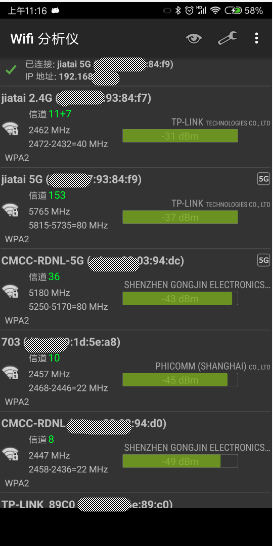前言:下载了WiFi分析仪,发现WiFi分析仪会显示当前扫描AP的信道,但是信道是没有公开接口的,那WiFi分析仪如何获取的呢?
参考:
1.https://blog.csdn.net/strugglelg/article/details/38927633(WiFi基本知识)
2.https://blog.csdn.net/strugglelg/article/details/38893287(2.4G wifi 的频道/信道 20M 40M的概念,区别)
1.WiFi分析仪

WiFi分析仪扫描结果如上,可以看到扫描到的消息是ap的ssid、BSSID、信道、当前频率、加密方式,当前连接AP、ip地址和路由器厂商,我用的是TP-LINK 2.4G+5G的路由器。
2.ScanResult

ScanResult是代表扫描结果的,当时其声明的成员变量并没有带有channel,那WiFi分析仪是如何获取信道的呢?
3.获取信道方法
3.1 频谱划分
1)IEEE 802.11b/g标准工作在2.4G频段,频率范围为2.400—2.4835GHz,共83.5M带宽
2)划分为14个子信道
3)每个子信道宽度为22MHz
4)相邻信道的中心频点间隔5MHz
5)相邻的多个信道存在频率重叠(如1信道与2、3、4、5信道有频率重叠)
6)整个频段内只有3个(1、6、11)互不干扰信道
3.2 2.4GHz中国信道划分

3.3 计算信道
举个例子,比如我用的2.4G的AP,虽然比较慢,我都用的5G的

ap的频率为2462MHz,而2462MHz是信道11的中心频率,WiFi分析仪则认为该AP是处于信道11上,那后面11+7是什么意思呢?
这是40MHz 信道宽度的AP。
40MHZ 实际上是用了两个频道, 20MHZ 实际上是用了1个频道 。
每个子信道宽度为22MHz,然后40MHZ的宽度相当于将左边临近的一个不重叠的信道包含进来,加起来恰好是40MHz左右,11信道左边不重叠的是7信道,这也就是信道11+7表示的含义。
4. ScanResult PS
信道宽度
/**
* AP Channel bandwidth is 20 MHZ
*/
public static final int CHANNEL_WIDTH_20MHZ = 0;
/**
* AP Channel bandwidth is 40 MHZ
*/
public static final int CHANNEL_WIDTH_40MHZ = 1;
/**
* AP Channel bandwidth is 80 MHZ
*/
public static final int CHANNEL_WIDTH_80MHZ = 2;
/**
* AP Channel bandwidth is 160 MHZ
*/
public static final int CHANNEL_WIDTH_160MHZ = 3;
/**
* AP Channel bandwidth is 160 MHZ, but 80MHZ + 80MHZ
*/
public static final int CHANNEL_WIDTH_80MHZ_PLUS_MHZ = 4;
/**
* AP Channel bandwidth; one of {@link #CHANNEL_WIDTH_20MHZ}, {@link #CHANNEL_WIDTH_40MHZ},
* {@link #CHANNEL_WIDTH_80MHZ}, {@link #CHANNEL_WIDTH_160MHZ}
* or {@link #CHANNEL_WIDTH_80MHZ_PLUS_MHZ}.
*/
public int channelWidth;中心频率
/**
* Not used if the AP bandwidth is 20 MHz
* If the AP use 40, 80 or 160 MHz, this is the center frequency (in MHz)
* if the AP use 80 + 80 MHz, this is the center frequency of the first segment (in MHz)
*/
public int centerFreq0;
/**
* Only used if the AP bandwidth is 80 + 80 MHz
* if the AP use 80 + 80 MHz, this is the center frequency of the second segment (in MHz)
*/
public int centerFreq1;ssid
/**
* The network name.
*/
public String SSID;
/**
* Ascii encoded SSID. This will replace SSID when we deprecate it. @hide
*/
public WifiSsid wifiSsid;
/**
* The address of the access point.
*/
public String BSSID;
/**
* The HESSID from the beacon.
* @hide
*/
public long hessid;信号强度
/**
* The detected signal level in dBm, also known as the RSSI.
*
* <p>Use {@link android.net.wifi.WifiManager#calculateSignalLevel} to convert this number into
* an absolute signal level which can be displayed to a user.
*/
public int level;5.总结
信道总体来讲是没有直接接口获取的,但可以通过AP的频率和信道宽度算出来,注意40MHZ信道宽度的AP占据了两个信道。
